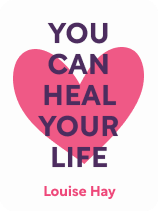

This article is an excerpt from the Shortform book guide to "You Can Heal Your Life" by Louise Hay. Shortform has the world's best summaries and analyses of books you should be reading.
Like this article? Sign up for a free trial here.
Are you critical of yourself or others? Do you struggle with relationships, money, or work?
In her book You Can Heal Your Life, Louise Hay argues that negative experiences in childhood cause us to form negative beliefs about the world, which in turn manifest in negative life experiences in adulthood. She says that the solution is simple: By transforming your negative thoughts into positive ones, you can create positive experiences in your life.
Below is a brief overview of You Can Heal Your Life by Louise Hay.
You Can Heal Your Life
In her You Can Heal Your Life book, self-help guru Louise Hay argues that your thoughts and your problems are directly related. She claims that negative beliefs—such as thinking we’re not good enough or blaming other people for our problems—actually bring more problems into our lives.
Our guide organizes Hay’s advice into three sections. Part 1 discusses her beliefs about where our problems come from. Part 2 explores how we can solve those problems. And Part 3 offers advice for specific types of problems.
We place Hay’s ideas in context by examining the ways in which recent advancements in the fields of psychology, medicine, and neuroscience shine new light on Hay’s ideas, supporting some and calling others into question. We also contrast Hay’s theories with those in other popular self-help and wellness books, such as Think and Grow Rich, Loving What Is, and The Body Keeps the Score.
Part 1: All Problems Are Rooted in Negative Childhood Experiences
Hay claims that all of the problems in our lives are the result of two things: negative experiences in childhood and the belief systems that form as a result.
Negative Childhood Experiences Create Negative Beliefs
Hay says that when we’re children, we mirror the thoughts of the adults around us. For example, if your parents told you that you were stupid when you were a kid, you’re likely to believe that you’re stupid later in life—and to talk to yourself in the same shaming way that your parents once talked to you. (If, on the other hand, they praised you and constantly reminded you how much they loved you, you’re likely to love yourself when you’re older.) Similarly, if your parents were cruel to each other or to you, you learn to relate to others with cruelty.
Negative Beliefs Create Negative Experiences
Hay asserts that once our belief systems are formed in childhood, we spend our lives “creating” experiences that mirror those beliefs. Therefore, our negative thoughts result in negative experiences: All external problems (our experiences) are manifestations of inner problems (our beliefs).
How exactly does this happen? Hay claims that the belief systems we learned as children act as a type of filter through which we view the world, causing us to accept as “true” only the experiences or information that confirm our existing, subconscious beliefs. For example, if you were told as a child that you were a failure who would never amount to anything, then you’ll subconsciously believe that you’re a failure. Even if you go on to live a life full of career or personal successes, you’ll focus on your mistakes instead—and continue to see yourself as a failure. In this way, your thoughts “become” your reality.
Not only do your subconscious beliefs affect your perspective on the world, argues Hay, but your subconscious mind also believes everything your conscious thoughts tell it. When you think negative thoughts, your subconscious believes them to be true. Hay claims that as a result, you “attract” negative experiences into your life. For example, if you spill your coffee on your way to work and think to yourself, “This is the beginning of an awful day,” then your negative mindset will cause bad things to happen to you for the rest of the day.
Examples From Hay’s Life
Hay’s own life led her to believe that all problems are rooted in negative childhood experiences. She grew up poor during the Great Depression, with a stepfather who abused her. She was raped by a neighbor around the age of five, and was frequently told that it was her fault. She continued to experience sexual and physical abuse throughout her childhood until she ran away from home at age 15.
As Hay grew older, she had many relationships with abusive men. She believes this was because of the abuse she suffered as a child, which damaged her self-esteem so much that she unconsciously thought she deserved to be mistreated. Later, as her sense of self-worth improved and she stopped believing that she deserved abuse, she stopped dating abusive men.
In addition to her relationship issues, Hay was diagnosed with cancer as an adult. She already believed that cancer was caused by longstanding resentment and anger (and she’d written a book, Heal Your Body, arguing that negative thoughts can cause illness). She thought her own cancer was caused by resentment toward her parents for how they’d treated her when she was a child. Her childhood lacked love and her parents’ criticism of her had taught her to criticize herself, so she resolved after her cancer diagnosis to change her critical thoughts and start loving herself. She did this in part by repeating positive affirmations to herself in front of a mirror.
She also went to therapy. The therapist helped her release her anger about the abuse she’d suffered as a child, and also helped her understand that her parents had hurt her because they’d been hurt themselves. Understanding the ways in which her parents were damaged helped Hay have compassion for them and, ultimately, forgive them. Hay says that after only six months, by learning to love herself and forgiving those who’d hurt her, she cured herself of cancer. As we’ll see throughout this guide, Hay credits her healing with positive thinking, forgiveness, and self-love.
Part 2: Positive Thoughts Can Solve Our Problems
Hay asserts that just as negative thoughts create negative experiences, positive thoughts attract positive experiences. Thus, by transforming our negative thoughts into positive ones, we can resolve all of the problems in our lives, from relationship woes to serious illnesses and diseases.
She advocates three primary methods for changing our negative thoughts into positive ones: positive affirmations, forgiveness, and self-love. First, we’ll explore positive affirmations, which Hay claims are useful for changing all kinds of negative thoughts into positive ones. Next, we’ll examine forgiveness, which specifically involves changing thoughts of blame into thoughts of compassion. Last, we’ll look at self-love, which requires you to change self-hatred to self-acceptance.
Method #1: Harness the Power of Positive Affirmations
Positive affirmations are statements that you make to yourself, either out loud, in your head, or in writing, to counteract your negative thinking. Hay argues that if you dwell on your problems, they will only become worse, but if you substitute positive affirmations in place of negative thoughts, you can attract more positive experiences into your life. Hay reminds us that this is effective because your subconscious mind accepts your conscious thoughts as the truth. For example, if instead of thinking, “I’m so unhappy,” you think, “I am happy,” this positive affirmation will convince your subconscious that you really are happy.
(Shortform note: Most psychologists agree that positive affirmations don’t solve your problems simply by existing. However, some say that the act of repeating positive affirmations can calm anxiety and put you in a more clear frame of mind, which enables you to handle any situation with greater care and better decision making. In this way, you might feel more confident and positive and have better results than had you not repeated any affirmations at all.)
Begin With a Willingness to Change
When it comes to the process for using affirmations to create positive change in your life, Hay says that the first step is being willing to change. Because your negative beliefs create a subconscious need to engage in certain negative behaviors and habits, you have to be willing to let go of that need in order to heal.
For example, if you think that you’re odd and unlikeable, you may become dependent on binging TV shows to drown out the pain of your loneliness. To heal, Hay says that you must tell yourself that you’re willing to release the need for your bad habit or behavior—in this case, the need for TV binges. You must tell yourself that your thoughts created the problem and that you’re willing to give it up. For example, you could affirm to yourself, “I release the need for TV binges. My thoughts of unworthiness created this need to immerse myself in a fantasy world, and I am willing to give it up.”
(Shortform note: Depending on how you approach it, acknowledging how your thoughts created the problem can decrease or increase feelings of shame, which leads to fear, blame, and disconnection. We can infer that Hay would want us to decrease this negative feeling through our affirmations, so it might be helpful to mentally acknowledge the purpose the behavior served and then declare it no longer needed. For example, in this case, the affirmation might become: “I release the need for TV binges. I used to feel unworthy, and immersing myself in a fantasy world gave me temporary relief. But I am willing to give it up in exchange for long-lasting happiness.”)
Once you’ve affirmed your willingness to change, you can take the next step: turning your desired changes or problems into positive affirmations. For example, you could say to yourself, “I love and accept myself, and I am worthy of love,” or “I have a healthy relationship with streaming shows.” Note that these affirmations are stated in the present tense—Hay says that this is crucial. It tells your subconscious mind that, for example, you love yourself now, rather than telling it that you will love yourself at some point in the future. In this way, you can avoid putting off solving your problems.
Use Affirmations Consistently and Holistically
While Hay believes that positive affirmations can solve your problems and change your life, she does issue a few caveats when it comes to relying on them. First, she says that if you want to heal yourself, you have to practice every day: If you’ve been relying on negative thinking your whole life, it’s not something you can change overnight. (Shortform note: How often is often enough? Some say to begin with repeating your affirmation ten times when you wake up and ten times when you go to bed, and build from there.)
Second, Hay cautions that she doesn’t have all the answers and that different healing techniques work for different people. She advocates a holistic approach to healing that addresses the body, the mind, and the spirit, and includes practices like eating healthy foods and meditating. (Shortform note: The mind-body-spirit connection is a tenet of many ancient and indigenous belief systems, particularly as it relates to healing.)
Method #2: Forgive to Change Blame to Compassion
The second method Hay advocates for transforming negative thoughts into positive ones is forgiveness. Hay argues that by using forgiveness to change thoughts of blame into thoughts of compassion, we can leave the negative experiences of our past behind and move forward with our lives. We can even rely on forgiveness to heal from disease, as Hay did.
Forgive to Let the Past Go
Hay explains that we often blame other people for our problems, but blaming others actually makes our problems more entrenched. By placing the blame on others, we fail to take responsibility for ourselves and the problem goes unsolved. Because our thoughts create our reality, she says, we are the ones responsible for everything that happens to us. Rather than blaming someone for an error they made, it’s better to practice forgiveness and assume responsibility.
Hay says that one exercise you can do to practice forgiveness is to say out loud to yourself the name of the person you need to forgive, then state that you forgive them and identify the specific action or behavior for which you’re forgiving them. Another approach is to imagine the person you have the hardest time forgiving, then visualize good things happening to them.
Because negative childhood experiences can have such an outsized impact on our lives, Hay believes it’s particularly important to forgive your parents. She advocates forgiving your parents or caregivers for the ways in which they’ve wronged you—not to give them a “free pass” for their behavior, but to help you move forward with your own life. She suggests asking your parents what their childhoods were like to better understand why they acted the way they did. This will allow you to have more compassion for them, which in turn will allow you to have more compassion for yourself. They were hurt, and they hurt you—but you don’t have to keep hurting yourself, says Hay.
Hay says that once you’ve bestowed forgiveness on the person who you once blamed for your problems, you’ll be able to take control of the situation and begin to solve it. (Shortform note: In The Subtle Art of Not Giving a F*ck, Mark Manson makes a clear distinction between blame and responsibility. He says that blame is related to who caused the problem, but responsibility is related to who needs to solve it. This is an empowering mindset—you have no control over what happens to you, but you do have control over how you handle it.)
Forgive to Heal From Disease
Hay claims that just as she cured her cancer by forgiving her parents for her abusive childhood, so too can anyone heal from illness if they forgive the people who’ve hurt them. Similarly, she contends that failing to forgive those who hurt you can make you sick, as she says happened to her. In fact, Hay asserts that failing to forgive is the cause of all disease. Bottling up your resentment and anger can eat away at your body and manifest in all types of illnesses. Only by letting that blame go can you heal from disease.
Method #3: Love Yourself—Changing Self-Hatred to Self-Acceptance
While forgiveness can help us leave the past behind and heal from disease, self-love, argues Hay, is the answer to every problem. Self-love does not mean narcissism or having a big ego. It means believing you’re valuable just as you are.
Hay says that everyone she’s ever known has felt some amount of self-hatred or guilt. Everyone feels that they’re not good enough. Why? Hay claims it’s because of the negative beliefs we pick up from adults when we are children. One way to identify and dismantle these beliefs is to make a list of everything your parents (and all the other adults in your life) said was wrong with you. You could also list all the things people told you that you should or shouldn’t do, like becoming a doctor or lawyer, or being less bossy. Next, consider the extent to which your own beliefs about yourself echo those negative or prescriptive beliefs instilled in you by your parents. Armed with this knowledge, you can recognize when the familiar negative self-beliefs creep in and use your affirmations instead.
In order to transform your self-hatred and self-criticism into self-love, Hay instructs that you must never criticize yourself for anything. You need to love and approve of yourself exactly as you are, flaws and all. (Shortform note: Because Hay advocates using affirmations to change problem behaviors, we can infer here that she’s not implying that flaws should go unchanged, just that they should go uncriticized. She would likely advise you to approach them with positive phrasing, as with the affirmations.)
If you don’t believe you deserve good things, you’ll never get them, says Hay. You can use mirror work to learn to feel that you deserve positive experiences. Look in the mirror and tell yourself that you deserve to have or be whatever specific thing you desire. For example, you could say “I deserve this promotion,” or “I deserve to be treated with respect and kindness.”
Another way to begin to love yourself is to constantly tell yourself that you approve of yourself. Each time you have a negative thought about yourself, turn it into a positive affirmation. For example, if you think to yourself, “I’m so dumb, why can’t I figure this out?” look in the mirror and state, “I’m smart and curious, and I’m able to teach myself to do hard things.”
(Shortform note: Research confirms that self-compassion—treating yourself as you would treat a close friend—can make you more successful, happier, and less stressed. Self-compassion can make you more productive because it allows you to see obstacles or failures as learning opportunities, rather than as evidence that you’re not good enough or you don’t have what it takes to succeed. And just as criticizing yourself can make it harder to pick yourself up after a failure, it can also activate your fight-or-flight response, releasing more of the stress hormone cortisol. Self-compassion, on the other hand, can calm your sympathetic nervous system and decrease stress.)
Part 3: Using Positive Thinking to Solve Specific Types of Problems
Once you have learned to transform your negative thoughts into positive ones through positive affirmations, forgiveness, and self-love, you can continue to use positive thinking to solve specific types of problems that you encounter in your life. Hay says that turning negative beliefs into positive affirmations can solve problems involving relationships, money, work, and illness.
Relationship Problems
Hay asserts that the things we don’t like about other people are simply reflections of the things we don’t like about ourselves: Our relationships are reflections of our beliefs. Therefore, if we learn to love our own flaws and quirks, we will no longer be frustrated or annoyed when we encounter those qualities in others.
For example, if you have a friend who you feel is selfish and unreliable, this could be because you believe that you can be selfish and unreliable, and you are projecting your beliefs about yourself onto your friend. Or it could be because you learned as a child that everyone is selfish and unreliable. To address the problems in your relationship, you could use mirror work and positive affirmations to learn to love the selfish and unreliable aspects of yourself, which will translate to forgiveness toward them. Alternatively, you could use these techniques to affirm to yourself that people are generous and reliable, until you believe it—your positive outlook will attract generous, reliable people into your life as a result.
(Shortform note: While Hay’s method for solving relationship problems appears to encourage some reflection about the cause of the problems, it primarily focuses on positive affirmations. One of the risks of using positive affirmations to address relationship challenges, however, is that it encourages people to ignore their problems, focus on the positive, and not communicate with the other person. But all relationships (except your relationship with yourself) involve at least two people, and failure to acknowledge shared issues, much less discuss them with the other person, can destroy interpersonal communication and lead to further relationship breakdown.)
Money Problems
Like relationship problems, money problems are rooted in a lack of self-love, says Hay. If you want to be wealthy, you first need to feel that you deserve it. If you have negative beliefs about money or your relationship with it, it will be hard for you to accumulate wealth.
Money is in endless supply, asserts Hay, and the only thing keeping us from having money is ourselves. She suggests various ways to change your negative beliefs about money into positive ones:
- Show gratitude: Be grateful for everything you do have.
- Clear the way for abundance: Get rid of old possessions that you don’t use in order to clear the way for new material goods to enter your life.
- Appreciate your bills: Appreciate the bills you receive rather than resenting or fearing them. See bills as evidence that a creditor believes you have the money to pay them.
- Demonstrate generosity: Be happy for other people’s prosperity and generous with the money you do have.
- Accept compliments: If you learn to accept the gift of a compliment, you will attract other types of prosperity to you as well.
Hay claims that each of these approaches will change your negative mindset about finances into a positive one, opening the door for more money to flow into your life.
(Shortform note: Hay’s belief that changing your negative thoughts about money into positive ones can attract more wealth into your life is similar to Napoleon Hill’s theory in Think and Grow Rich. He says that if you fill your mind with thoughts of financial success, you can achieve riches. Both Hay and Hill believe that your thoughts create your reality. However, Hill’s recipe for prosperity includes a few steps that Hay omits: He says that in addition to thoughts and desires, wealth also requires planning, work, and persistence. It’s not enough to believe you can become rich— you also need a plan for how to make money, and you must push through obstacles without quitting until you achieve your goals.)
Work Problems
Hay says you can also solve work problems by focusing on the positive. She claims that if you don’t like your job or a particular aspect of your work, the solution is not to think about how much you hate it. Instead, you should bless it with love and express positive affirmations about what you want in your career.
For example, you could say, “I have the best boss,” “I am using my talents to their utmost,” or, “I am in a leadership role.” These positive affirmations will eventually change your belief system and, accordingly, lead to improvements in your work situation.
(Shortform note: While having a positive attitude is undoubtedly beneficial in any work environment, research indicates that many of the factors that contribute to a positive work experience are outside of an employee’s immediate control. Workplaces that are able to retain the best employees often share characteristics such as fair pay, work-life balance, meaningful work, and empowering employees to provide input and develop their skills.)
Illness and Disease
Hay believes that, like all of our problems, illness and disease are caused by negative thoughts. She says that there are specific thought patterns that correspond to every conceivable ailment, and she provides a list of mental and physical health issues and the thoughts that likely caused each one of them. For example, she says that deafness results from refusing to listen to someone and sore throats are caused by feeling angry. Hay believes that our thoughts even cause cancer and AIDS. She claims that AIDS is caused by thinking that you’re not good enough and no one cares about you, as well as by sexual guilt.
To heal any condition, says Hay, you need to first affirm to yourself that you’re letting go of the thoughts that created the condition. Then, you need to repeat the affirmation Hay provides to create new beliefs.
Hay also claims that harmful accidents aren’t really accidental; they are caused by our anger at ourselves. The degree of bodily harm caused by an accident correlates with the extent to which we want to punish ourselves. In fact, Hay believes that at the root of every disease are variations on just two emotions: anger and fear.
(Shortform note: As we’ve discussed, attempting to cure illness using positive thinking alone can be dangerous or even deadly: It can result in psychological and physical harm. While research doesn’t support this course of action, it does validate the broader concept of a mind-body connection—the idea that our thoughts, emotions, and overall outlooks can affect our physical health, just as our physical health can affect our mental states. While some mind-body practices, such as talk therapy, address the “mind” side of the equation, many focus instead on the “body” side, using practices such as Tai chi, yoga, meditation, and relaxation techniques to help alter your mental state and reduce your stress, leading to better health.)

———End of Preview———
Like what you just read? Read the rest of the world's best book summary and analysis of Louise Hay's "You Can Heal Your Life" at Shortform.
Here's what you'll find in our full You Can Heal Your Life summary:
- The causes and effects of negative beliefs
- How to transform your negative thoughts into positive ones
- How to solve your problems with relationships, money, work, and even illness






